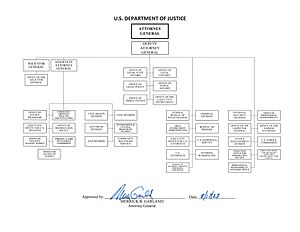United States Department of Justice facts for kids
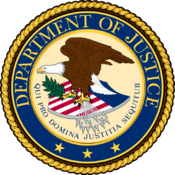
Seal of the U.S. Department of Justice
|
|
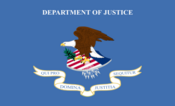
Flag of the U.S. Department of Justice
|
|
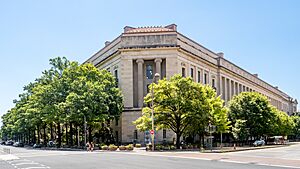 The Robert F. Kennedy Building is the headquarters of the U.S. Department of Justice. (2024) |
|
| Agency overview | |
|---|---|
| Formed | July 1, 1870 |
| Type | Executive department |
| Jurisdiction | U.S. federal government |
| Headquarters | Robert F. Kennedy Department of Justice Building 950 Pennsylvania Avenue NW Washington, D.C., United States 38°53′36″N 77°1′30″W / 38.89333°N 77.02500°W |
| Motto | "Qui Pro Domina Justitia Sequitur" (Latin: "Who prosecutes on behalf of justice (or the Lady Justice)") |
| Employees | 113,114 (2019) |
| Annual budget | $37.52 billion (FY 2024) |
| Agency executives |
|
The United States Department of Justice (DoJ), also known as the Justice Department, is a part of the U.S. government. Its main job is to make sure federal laws are followed and that justice is carried out across the country. It's like the "Ministry of Justice" you might find in other countries.
The person in charge of the Justice Department is called the U.S. Attorney General. This person works directly for the president of the United States and is a member of the president's main team, called the Cabinet. As of July 2025, Merrick Garland serves as the U.S. Attorney General.
The Justice Department includes most of the United States' main federal law enforcement agencies. These include the Federal Bureau of Investigation (FBI), the U.S. Marshals Service, the Bureau of Alcohol, Tobacco, Firearms and Explosives (ATF), the Drug Enforcement Administration (DEA), and the Federal Bureau of Prisons. The department also has many lawyers who represent the government in court cases.
The U.S. Congress officially created the Justice Department in 1870. However, its work began much earlier, in 1789, when the job of Attorney General was first created.
Contents
Understanding the Justice Department's Role
The Justice Department is a very important part of how the U.S. government works. It helps keep people safe and makes sure laws are applied fairly.
What Does the Justice Department Do?
The Justice Department has several key responsibilities:
- Enforcing Federal Laws: This means making sure people and groups follow laws that apply across the entire country.
- Representing the U.S. Government: Its lawyers go to court to defend the government or bring cases on its behalf.
- Leading Law Enforcement: Many major federal police agencies are part of the Justice Department.
- Protecting Civil Rights: It works to ensure that everyone's basic rights are protected under the law.
How the Justice Department Started
The idea of having a top lawyer for the government began in 1789. This person, the Attorney General, gave legal advice to the president and Congress.
Early Days of the Attorney General
At first, being the Attorney General was a part-time job. The person holding the job often had their own private law practice to earn more money. Over time, the job became bigger and more important.
For example, Edward Bates was Attorney General under President Abraham Lincoln. He had a small team, and their main job was to give legal advice when asked. They also handled a few cases in the Supreme Court.
Creating the Department of Justice
People realized that the government needed a full-time legal department. In 1867, a group in Congress started looking into creating a "law department."
On June 22, 1870, President Ulysses S. Grant signed a bill into law. This bill officially created the Department of Justice.
New Responsibilities for the Department
With the new department, the Attorney General's job grew a lot. They became responsible for:
- Overseeing all U.S. attorneys across the country.
- Handling all federal crime cases.
- Representing the United States in all court cases.
The new law also created the job of Solicitor General. This person's job is to manage and argue government cases in the Supreme Court of the United States.
Fighting for Civil Rights
One of the first big tasks for the new Justice Department was to protect civil rights. This was especially important after the American Civil War.
Protecting Rights in the 1870s
The department worked hard to fight against groups that used violence to oppose new laws. These laws, like the 13th, 14th, and 15th Amendment, gave more rights to all citizens.
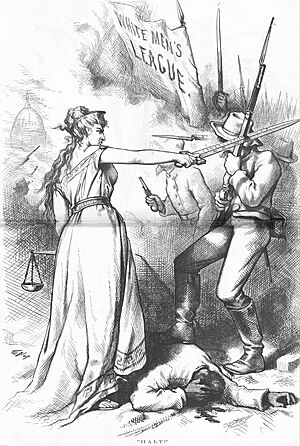
In the early 1870s, the Justice Department successfully prosecuted many members of groups like the Ku Klux Klan. This led to a big drop in violence in the Southern states.
Expanding Responsibilities and Prisons
As the country grew, so did the Justice Department's duties.
- In 1887, it took on more law enforcement tasks related to trade between states.
- In 1884, the department became responsible for federal prisons. New prisons were built, like the one in Leavenworth.
- In 1933, President Franklin D. Roosevelt gave the department even more power. It became responsible for handling all court cases for and against the U.S. government.
Where the Justice Department Works
The main building for the U.S. Department of Justice is in Washington, D.C. It's a very large building completed in 1935.
The Robert F. Kennedy Building
The building is located between Constitution and Pennsylvania Avenues. It has over 1 million square feet of space! In 2001, it was renamed the Robert F. Kennedy Department of Justice Building to honor a former Attorney General.
The Department's Motto
The Justice Department's official seal has a Latin motto: Qui Pro Domina Justitia Sequitur. This means "Who prosecutes on behalf of justice (or the Lady Justice)." It shows that the department's goal is to serve justice itself.
How the Justice Department is Organized
The Justice Department is made up of many different offices, divisions, and agencies. They all work together to carry out the department's mission.
Main Leaders
- Attorney General: The head of the department.
- Deputy Attorney General: The second in command.
- Associate Attorney General: The third highest-ranking official.
- Solicitor General: Represents the government in the Supreme Court.
Key Divisions
The Justice Department has several divisions, each focusing on a specific area of law:
- Antitrust Division: Deals with fair competition in business.
- Civil Division: Handles lawsuits involving the government.
- Civil Rights Division: Protects the civil rights of all Americans.
- Criminal Division: Focuses on federal criminal cases.
- Environment and Natural Resources Division: Works on environmental laws and natural resources.
- National Security Division: Deals with threats to national security.
- Tax Division: Handles cases related to taxes.
Federal Law Enforcement Agencies
Many well-known federal law enforcement agencies are part of the Justice Department:
- United States Marshals Service (USMS): One of the oldest federal law enforcement agencies, established in 1789. They protect courts and transport prisoners.
- Federal Bureau of Investigation (FBI): Created in 1908, the FBI investigates a wide range of federal crimes.
- Federal Bureau of Prisons (BOP): Manages the federal prison system.
- Bureau of Alcohol, Tobacco, Firearms and Explosives (ATF): Deals with illegal firearms, explosives, and certain other regulated items.
- Drug Enforcement Administration (DEA): Works to stop illegal drug trafficking and enforce drug laws.
- Office of the Inspector General (OIG): Checks if the Justice Department itself is working properly and honestly.
Other Important Offices
The Justice Department also has many other offices that handle specific tasks, such as:
- Executive Office for Immigration Review (EOIR): Handles immigration court cases.
- Office of Justice Programs (OJP): Provides grants and support for state and local justice programs.
- Office of Legal Counsel (OLC): Gives legal advice to the President and executive branch agencies.
- Office of Public Affairs: Communicates with the public and the media.
- Office on Violence Against Women (OVW): Works to prevent violence against women.
Finances and Budget
The Justice Department receives a large budget from Congress to carry out its many duties. This money helps fund law enforcement, court cases, prisons, and grants for local programs.
| Program | FY 2022 (millions) | FY 2023 (millions) | FY 2024 proposed (millions) |
|---|---|---|---|
| Law Enforcement | $19,286 | $20,543 | $21,292 |
| Litigation | 1,552 | 1,752 | 2,091 |
| Admin/Technology/Other | 880 | 652 | 2,009 |
| Prisons and Detention | 10,223 | 10,802 | 9,988 |
| State and Local Grants | $3,630 | $4,195 | $4,912 |
| ATR and USTP Fees | (551) | (459) | (556) |
| Total, Discretionary BA with Fees | $35,020 | $37,485 | $39,736 |
Images for kids
-
Thomas Nast illustration entitled "Halt," published October 17, 1874
See also
 In Spanish: Departamento de Justicia de los Estados Unidos para niños
In Spanish: Departamento de Justicia de los Estados Unidos para niños


